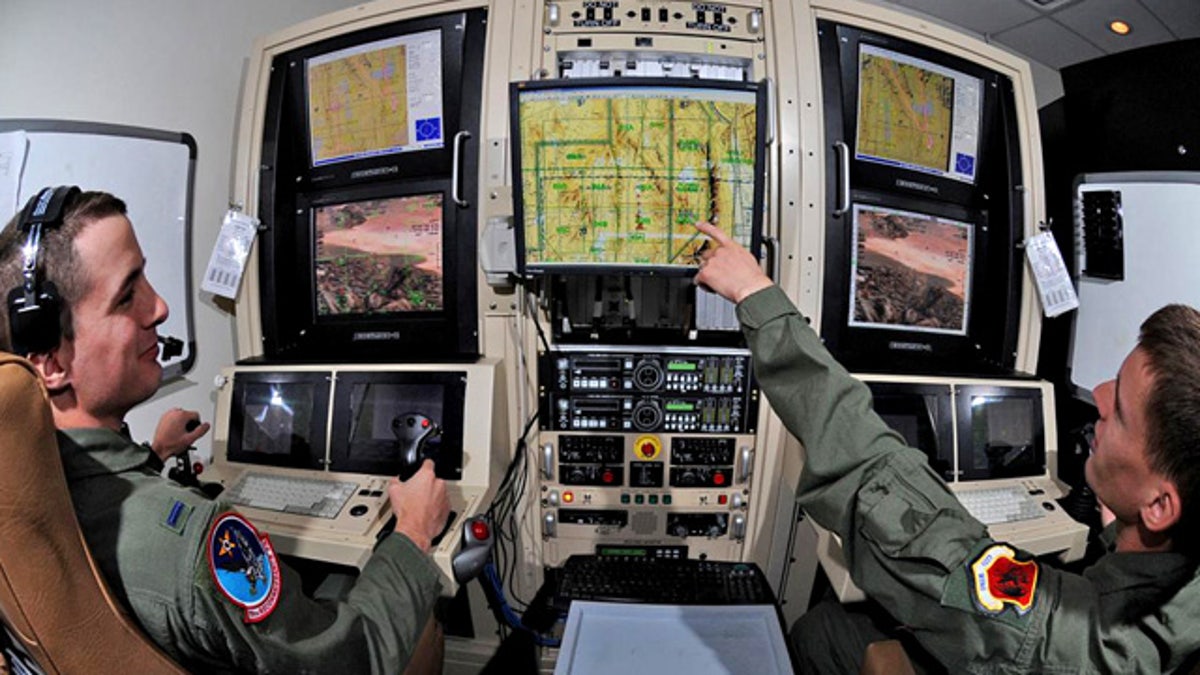
Airman 1st Class Caleb Force assists 1st Lt. Jorden Smith, a MQ-1B Predator pilot, in locating simulated targets during a training mission conducted inside the simulators at Creech Air Force Base, Nev. (U.S. Air Force / Senior Airman Nadine Y. Barclay)
Teenagers raised on "Call of Duty" and "Halo" might relish flying a massive Predator drone -- a surprisingly similar activity.
Pilots of unmanned military aircraft use a joystick to swoop down into the battlefield, spot enemy troop movements, and snap photos of terror suspects, explained John Hamby, a former military commander who led surveillance missions during the Iraq War.
“You’re always maneuvering the airplane to get a closer look,” Hamby told FoxNews.com. “You’re constantly searching for the bad guys and targets of interest. When you do find something that is actionable, you’re a hero.”
Yet a new study at the Massachusetts Institute of Technology (MIT) found real-life drone operators can become easily bored. Only one participant paid attention during an entire test session, while even top performers spent a third of the time checking a cellphone or catching up on the latest novel.
'You’re constantly searching for the bad guys and targets of interest. When you find something actionable, you’re a hero.'
That’s a problem, said Mary Cummings, an associate professor of aeronautics and astronautics at MIT. Not being cognizant of the battlefield means drone operators could miss important mission objectives.
Fortunately, there’s an answer: making the actual drone mission even more like a video game.
“When there was a lot going on, people did very well,” she told FoxNews.com. “When there was nothing going on they did much worse. When it’s boring most of the time, most do not pay attention.”
Cummings -- who goes by the name Missy -- is a former F-18 pilot herself, and was surprised by the results of the drone study, which was sponsored by the U.S. Navy. She pointed out that the FAA insists all aircraft personnel doing monitor and surveillance work should be in a sterile environment, without any distractions. Yet, drone reconnaissance mission can last up to 24 hours, and a sterile environment could be making things worse.
She says those who had more to do during the study performed better. Interestingly, she also found operators who had more experience playing video games did worse -- they could not deal with the boredom as easily, particularly during long missions.
And a drone pilot clearly has to pay attention. There are long periods when an operator might not see anything, and those types of missions could become dull. “Someone has to watch that camera or you won’t catch the bad guys before they catch us,” Hamby told FoxNews.com.
Cummings says the secret could be to make drone missions work more like a video game. That’s the opposite of the trend in the automotive industry, where distracted driving can lead to more frequent accidents and higher fatalities.
“We need to rethink this, because some level of distraction actually helps,” she said. The lessons about providing more to do when flying a drone can also translate to other fields, she said. For example, those in charge of nuclear safety at power plants might be better off not staring at a bland screen all day. Even those in the medical field could benefit from having objectives akin to a video game.
Hamby said the younger generation of video gamers is well-suited for real military combat. In fact, the controller for some surveillance drones is modeled after a video game controller. He also says many of the objectives look and function the same. The real military use a touchscreen notebook to control drones; you can land one by touching an airstrip, and the drones essentially fly on their own.
Travis Getz, a spokesperson for Tom Clancy Games and the company’s liaison with the U.S. military, said games like “Ghost Recon: Future Soldier” are not designed to simulate real drone missions. But they do have the same ambiance as a theater of war: finding the enemy, relaying strategic initiatives.
“The result of interacting with drones for gamers and trained military operators is the same – they get more ways to view and interact with an area or situation from multiple angles or with vision enhancements like thermal or infrared,” he told FoxNews.com. The benefit might not be more busy work for an operator, but would increase the thoroughness of the surveillance and the results.
For now, the MIT findings are too new for any immediate action – there are no plans to start porting the military’s drone control screens to the Nintendo Wii. But Cummings says we know more about how to make sure people are paying attention, and not just visiting the snack room.
